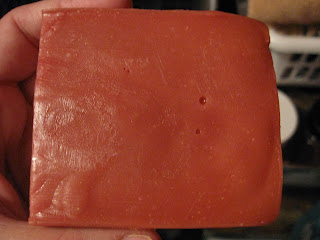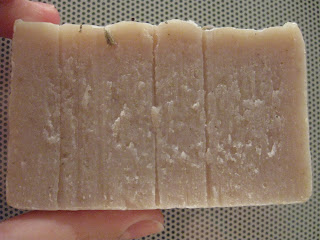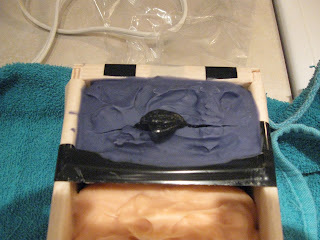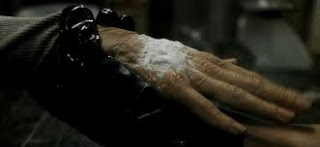In our post about infusing spices in coconut oil we mentioned that we would be updating you on how the soap turned out. Well, last night we made 8 half pound test batches and we have lots of pictures to show you. Yes, we only told you about 4 of the colors we were planning to try but since then some things changed. For one, the madder root did not leave any color in the oil so we left that one out and we added 5 others.
Method:
Each color infusion was used at a rate of 10% of the total oils in the recipe.
Oil and lye solution was mixed together at 125 degrees F
Once moulds were full they were insulated and placed in the oven.
Let’s start with the yellows:
The oils below were strained through coffee filters before use. Calendula and Annatto were steeped for 1 week. Paprika and Turmeric were steeped for 2 weeks.
Left to Right - Calendula-Turmeric-Annatto-Paprika
This is what they looked like once we poured them into the moulds. We made each batch one at a time so the batch on the left is freshly poured while the rest had already been sitting for a bit.
Left to Right - Calendula-Turmeric-Annatto-Paprika
This is what they looked like while they were gelling. You can see what we meant by translucent in my post about the gel stage in this picture.
Left to Right - Calendula-Turmeric-Annatto-Paprika
And here is the soap fresh from the mould after sitting over night in the oven.
Left to Right - Calendula-Turmeric-Annatto-Paprika
Here is the soap cut into bars:
Paprika
One of us......ahem.....(the one not typing this blog)....forgot to add the castor oil to the recipe so this one is a bit crumbly looking. The color looks a lot like orange creamsicle. It won’t be used though because with the missing oil it will be very lye heavy.
Annatto Seed Powder
This one, predictably, looked like cheese. Did you know that Annatto is used to color cheddar cheese? (Yes, it is spelled wrong in the picture)
Turmeric
We thought this one would be a brighter yellow. The bar on the bottom is closer to what the color actually looks like. The camera used to take the pictures does not want to capture the color very accurately. (Ok, Turmeric is spelled wrong too)
Calendula Petals
Where is the color you say? That's right, it’s not there....no color showed through at all on this one. Calendula petals are usually put right into the soap for colour...they stay yellow after coming into contact with the lye. We wanted to see if calendula infused in oil would leave any color...it did not.
Ok, on to the purples.
These oils were also strained through coffee filters before use. Ratan Jot steeped for 2 weeks. The yellow dock root and the rosehips steeped for 1 week. The item on the right is dragon's blood resin, crushed into a powder. We added 0.10 oz of that to the half pound batch while mixing.
Left to Right - Ratan Jot-Yellow Dock Root-Rosehips-Dragon’s Blood Resin
Here are the purples after pouring. The dragon’s blood resin soap on the right is freshly poured in this picture while the ratan jot, yellow dock and rosehip soap has been sitting for a while. You can see that the gel process has already started in those.
Left to Right - Ratan Jot-Yellow Dock Root-Rosehips-Dragon’s Blood Resin
We had a bit of a volcano with the ratan jot. One of us......ahem.....me this time, turned the oven on to warm it up a bit and forgot to turn it off. The soap got too hot and the ratan jot started to volcano.
Here are the purples fresh from the mould.
Left to Right - Ratan Jot-Yellow Dock Root - Rosehips - Dragon’s Blood Resin
And here are the cut purples.
Dragon’s Blood Resin (Daemonorops Draco)
The dragon’s blood turned out better than we expected. It looks more orange in this picture but the actual soap is a light brown orange with flecks of what looks like dried reddish blood. Sounds kind of gross when I describe it but it actually looks nice.
Rosehips
As predicted, the rosehips did not change the color at all. When held side by side, the rosehip soap and the calendula soap are identical. We had our doubts but we wanted to see if the rosehips would be pink like some soapers online say they will be. We plan to try putting rosehip powder right into the soap next time.
Ratan Jot Powder
This soap was very exciting when we made it. It started out as a bright vibrant blue and turned to this nice dark grey purple. The Ratan Jot behaves similar to Alkanet Root, which we have tried before but this turned out much darker. We want to try using less of the Ratan Jot oil and skipping the gel phase for another batch to see if it stays a bit more vibrant than this. Oh, and the volcano was cool, we have never had that happen before!
Yellow Dock Root Powder
The yellow dock root soap was disappointing. After reading online about the beautiful raspberry reds that some people were getting with this natural colorant, we were hoping to get a better color. Instead, the top of this soap is a faint light raspberry pink while the inside turned slightly yellow (you can't really see the yellow in the picture but it is there). Hopefully the color will change over time. In the meantime, we have plans to strengthen our yellow dock root infusion and use a higher percentage in the batch next time. We are determined to get that raspberry red!
We have some indigo, safflower petals, red clay, madder root and alkanet root on the way to experiment with next time so stay tuned!
















































